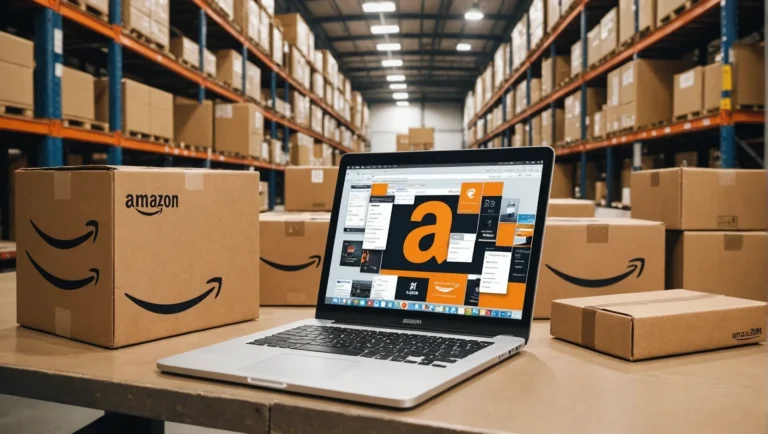Dropshipping on Amazon can be a lucrative business venture, but it’s not without its challenges. In this guide, we’ll walk you through the steps to start a successful Amazon dropshipping business in 2024, from setting up your seller account to scaling your operations for long-term growth.
Whether you’re a complete beginner or looking to expand your e-commerce portfolio, this guide will provide you with the knowledge and tools to navigate the competitive world of Amazon dropshipping.
Amazon's Market Share:
Amazon accounted for 37.6% of the U.S. ecommerce market in 2023.

Save 80% of delivery management time
We handle everything:
- Dedicated operations manager
- Real-time tracking dashboard
- Automated customer notifications
- Urgent issue resolution
How to Start Dropshipping on Amazon: Set Up Your Amazon Seller Central Account for Dropshipping
Create an Amazon seller account
To start dropshipping products on Amazon, you first need to create an Amazon seller account. Begin by visiting the Amazon Seller Central website and clicking on the “Sign up” button. You’ll be asked to choose between an individual or professional seller plan. Unlock the full potential of your Amazon dropshipping venture by crafting a comprehensive plan for your dropshipping business today.
The individual seller plan is suitable for those who plan to sell fewer than 40 items per month and don’t require advanced selling tools. With this plan, you’ll pay a $0.99 fee for each item sold. On the other hand, the professional seller plan is ideal for those who expect to sell more than 40 items per month and want access to advanced selling tools. This plan has a monthly subscription fee of $39.99, but you won’t be charged the $0.99 per item fee.
After selecting your selling plan, provide the necessary information, such as your business name, address, and tax ID. Amazon will also require you to complete the account verification process, which may involve providing additional documentation and verifying your identity.
Configure your seller account settings
Once your Amazon seller account is created, it’s time to configure your account settings. Start by setting up your payment and deposit methods. Amazon offers several payment options, including direct deposit, wire transfer, and Amazon Payments. Choose the method that works best for your business and provide the required information.
Next, customize your seller profile and storefront. This step is crucial for establishing your brand identity on Amazon. Add a professional logo, create a compelling “About Us” page, and showcase your products in an attractive manner. A well-designed storefront can help you stand out from the competition and attract potential customers.
Amazon Prime Membership:
The number of Amazon Prime members in the U.S. is expected to exceed 180 million in 2024.
Familiarize yourself with Amazon’s policies and guidelines
Before you start selling products on Amazon, it’s essential to familiarize yourself with the platform’s policies and guidelines. Amazon has strict rules regarding product quality, pricing, and customer service. Failing to comply with these policies can result in account suspension or even termination.
Take the time to read through Amazon’s seller policies and guidelines, which cover topics such as prohibited items, product authenticity, and shipping requirements. By understanding and adhering to these policies, you can ensure a smooth and successful dropshipping experience on Amazon.
Connect with a reliable dropshipping supplier
To start dropshipping on Amazon, you’ll need to partner with reliable dropshipping suppliers. These suppliers will store, pack, and ship your products directly to your customers on your behalf. Research and select suppliers that offer high-quality products, competitive prices, and reliable shipping times. Explore our guide to identifying supreme dropship suppliers to elevate your Amazon business’s efficiency and profitability.
Once you’ve identified potential suppliers, reach out to them and establish communication. Discuss your dropshipping plans and agree on terms, such as pricing, shipping methods, and return policies. It’s essential to build strong relationships with your suppliers to ensure a seamless drop shipping operation.
Integrate supplier inventory with your Amazon seller account
After partnering with dropshipping suppliers, you’ll need to integrate their inventory with your Amazon seller account. This process involves importing your suppliers’ product data, including titles, descriptions, images, and prices, into your Amazon listings.
Many dropshipping suppliers offer automated inventory management systems that can sync with your Amazon seller account, making the integration process more efficient. These systems can automatically update your listings when your suppliers’ inventory levels change, ensuring that you never sell out-of-stock items.
By following these steps and setting up your Amazon Seller Central account correctly, you’ll be well on your way to starting a successful dropshipping business on Amazon. In the next section, we’ll explore how to discover profitable dropshipping niches on Amazon.
Daily Sales by Third-Party Sellers:
In 2023, third-party sellers on Amazon sold over 4.5 billion items, averaging 8,600 items per minute.
How to Detect Amazon Dropshipping Profitable Niches
Conduct market research
Analyzing customer demand and trends is crucial for finding profitable dropshipping niches on Amazon. Start by exploring the Best Sellers and Movers & Shakers lists to identify popular product categories and specific items that are consistently selling well. Pay attention to the number of reviews, ratings, and the overall sales rank to gauge the level of demand for each product category.
Next, use keyword research tools like Jungle Scout, Helium 10, or Merchant Words to uncover high-volume, low-competition keywords related to your potential niches. These tools provide valuable insights into search volume, competition levels, and potential profit margins. By targeting keywords with high demand and low competition, you can increase your chances of success in the dropshipping market.
Finally, study successful competitors in your target niches to understand their pricing strategies, product offerings, and marketing tactics. Analyze their product listings, customer reviews, and social media presence to identify strengths and weaknesses that you can leverage or improve upon in your own dropshipping business.
Recommended keyword research tools
Jungle Scout: Offers a suite of tools for product research, keyword tracking, and competitor analysis.
Helium 10: Provides a comprehensive set of tools for keyword research, product validation, and listing optimization.
Merchant Words: Focuses on Amazon-specific keyword research and demand analysis.
Evaluate product profitability
Before investing in a product, it’s essential to assess its profitability. Calculate potential profit margins by considering the product cost, shipping expenses, and Amazon fees. Use the Amazon FBA Revenue Calculator to estimate your net profit margin after accounting for these costs. Aim for products with healthy profit margins that allow room for competitive pricing and potential promotions.
Amazon Seller Plans:
Amazon offers two seller account plans: the Individual plan for those selling fewer than 40 items per month and the Professional plan for businesses selling more than 40 items per month.
Product quality and supplier reliability are equally important factors to consider. Research potential suppliers thoroughly, read reviews from other sellers, and request product samples to ensure the items meet your quality standards. Building strong relationships with reliable suppliers is key to maintaining a consistent supply chain and avoiding stockouts or shipping delays.
Test and validate your product ideas
To minimize risk and validate your product ideas, start with a small inventory. This approach allows you to test the market demand and gather valuable feedback from customers without overcommitting resources. Closely monitor your sales performance, customer reviews, and feedback to identify areas for improvement and optimize your product offerings.
Based on the data-driven insights gained from your initial testing, adjust your product selection, pricing, and marketing strategies accordingly. Continuously iterate and refine your approach to maximize profitability and customer satisfaction. As your dropshipping business grows, gradually expand your product range and scale up your inventory levels to meet increasing demand.
Addressing common questions
Is $100 enough to start dropshipping?
While it’s possible to start dropshipping with a small budget, $100 may be challenging. You’ll need to allocate funds for product sourcing, advertising, and other operational costs. It’s recommended to have a slightly larger budget to ensure you can effectively test and validate your product ideas.
Is dropshipping a good idea for beginners?
Dropshipping can be a good entry point for beginners in e-commerce, as it requires less upfront investment and minimizes inventory risk. However, it’s crucial to approach dropshipping with realistic expectations and a willingness to learn and adapt. Success in dropshipping requires dedication, research, and continuous optimization.
Recommended resources for further learning
-
“The Ultimate Guide to Dropshipping” by Mark Hayes and Andrew Youderian: This comprehensive guide covers all aspects of starting and scaling a successful dropshipping business.
-
“Dropshipping 101: The Ultimate Guide to Building a Location-Independent Business with 0 Capital” by Joseph Hogue: This book provides practical insights and strategies for beginners looking to start a dropshipping business with minimal investment.
-
Dropship Weekly podcast: This podcast features interviews with successful dropshippers and industry experts, offering valuable tips and inspiration for aspiring entrepreneurs.
Optimizing Your Amazon Product Listings for Maximum Visibility
Optimizing your Amazon product listings is crucial for attracting potential customers and driving sales. By crafting compelling titles, and descriptions, and utilizing high-quality images, you can significantly improve your product’s visibility and appeal. Additionally, leveraging product reviews and ratings helps establish trust and credibility, further enhancing your chances of success in the competitive Amazon marketplace.
Craft compelling product titles and descriptions
Your product title and description are the first points of contact with potential customers. It’s essential to make them engaging, informative, and optimized for search.
Include relevant keywords in titles and descriptions
Conduct thorough keyword research to identify the most relevant and high-traffic keywords for your product. Incorporate these keywords naturally into your product title and description, ensuring they flow seamlessly without appearing spammy. For example, you can use tools like Google Keyword Planner or Helium 10 to find relevant keywords and check their search volume.
Highlight unique selling points and benefits
Focus on the unique features and benefits that set your product apart from competitors. Clearly communicate how your product solves customer problems or improves their lives. Use bullet points to make your description easy to read and scannable.
Ensure clarity, readability, and adherence to Amazon’s guidelines
Keep your product titles concise and descriptive, typically under 200 characters. Use proper capitalization and avoid special characters or excessive punctuation. In your product description, maintain a clear structure with short paragraphs, bullet points, and simple language. Familiarize yourself with Amazon’s product listing guidelines to ensure compliance and avoid potential issues.
Utilize high-quality product images
Visuals play a crucial role in capturing customer attention and conveying your product’s quality and value. Invest in high-quality product photography to showcase your items in the best possible light.
Provide multiple clear, high-resolution images per product
Include several images that highlight your product from different angles, showcasing its features, texture, and scale. Use a white or neutral background to maintain a clean and professional look. Ensure that your images are high-resolution, allowing customers to zoom in and examine details closely. Amazon recommends a minimum resolution of 1000×1000 pixels for the main product image.
Showcase products from various angles and in use
In addition to standard product shots, include lifestyle images that show your product in use or in context. This helps customers visualize how the product fits into their lives and can evoke an emotional connection.
Follow Amazon’s image requirements and best practices
Adhere to Amazon’s image guidelines, which typically require a minimum resolution of 1000×1000 pixels and a pure white background for the main product image. Optimize your image file names with relevant keywords and keep the file size under 10MB for faster loading times.
Leverage product reviews and ratings
Product reviews and ratings are powerful social proof elements that greatly influence customer purchasing decisions. Actively encourage and manage your product reviews to build trust and credibility.
Encourage customers to leave honest reviews
Include a polite request for customers to leave a review in your product packaging or follow-up emails. Make it easy for them to access your product review page by providing a direct link. Consider offering incentives, such as discount codes or free samples, for customers who leave reviews.
Respond promptly to customer inquiries and feedback
Engage with your customers by promptly addressing their questions, concerns, or negative feedback. Show genuine appreciation for positive reviews and offer solutions or apologies for negative ones. Demonstrating responsive and caring customer service can help mitigate the impact of negative reviews and enhance customer loyalty.
Maintain a high product rating to boost visibility and trust
Products with higher ratings and more reviews often rank better in Amazon search results and are more likely to convert visitors into customers. Continuously monitor your product ratings and strive to maintain an average rating of 4 stars or above. Regularly analyze customer feedback to identify areas for product improvement or customer service enhancement.
By implementing these optimization strategies, you can significantly improve your Amazon product listings’ visibility, attractiveness, and credibility. Continuously monitor and refine your listings based on customer feedback and performance metrics to ensure ongoing success in your Amazon dropshipping business.
Streamline order processing
Implementing an efficient system for receiving and processing orders is crucial for the success of your Amazon dropshipping business. When an order is placed, promptly communicate the order details to your dropshipping suppliers. This includes the product SKU, quantity, shipping address, and any special instructions or customization requests from the customer.
To ensure timely and accurate order fulfillment, establish clear communication channels with your suppliers. This can be done through email, phone, or preferably, an integrated order management system that automatically forwards order details to your suppliers. By automating this process, you minimize the risk of human error and reduce the time spent on manual order processing.
Best practices for order processing
-
Use an order management system that integrates with your Amazon seller account and dropshipping suppliers, such as Zoho Inventory or Skubana.
-
Set up email templates for quick and consistent communication with suppliers.
-
Regularly review and update supplier contact information to avoid communication breakdowns.
-
Monitor order status and proactively address any delays or issues with suppliers.
Monitor and manage inventory levels
Regularly updating inventory information in your Amazon seller account is essential to avoid overselling and maintain a positive customer experience. Set up automated alerts for low-stock or out-of-stock items to stay informed about your inventory levels. This allows you to reorder products from your suppliers before stock-outs occur, minimizing the risk of lost sales and negative customer feedback.
Maintaining a balance between inventory costs and customer demand is key to optimizing your profitability. While holding too much inventory can tie up your capital and increase storage costs, having too little can lead to lost sales and disappointed customers. Analyze your sales data and use demand forecasting tools to make informed decisions about your inventory levels.
Tips for effective inventory management
-
Regularly update inventory quantities in your Amazon seller account.
-
Use inventory management software such as InventoryLab or Sellbrite to automate stock-level tracking and reordering.
-
Establish reorder points based on lead times and sales velocity.
-
Consider using multiple suppliers for popular products to reduce the risk of stock-outs.
-
Implement a just-in-time (JIT) inventory system to minimize inventory holding costs and maximize efficiency.
Handle returns and refunds effectively
Clearly communicating your return and refund policies to customers is crucial for setting expectations and minimizing disputes. Process returns and refunds promptly to maintain customer satisfaction and protect your seller rating on Amazon. Work with your suppliers to establish a streamlined process for handling returns, including who is responsible for the cost of return shipping and how returned products will be processed.
To minimize return rates and costs, regularly monitor customer feedback and address any product quality or description issues promptly. Communicate with your suppliers to ensure that products are accurately described, properly packaged, and meet customer expectations. By proactively addressing potential issues, you can reduce the likelihood of returns and maintain a positive reputation on Amazon.
Cost considerations for starting an Amazon dropshipping business
While the upfront costs of starting an Amazon dropshipping business are relatively low compared to traditional retail models, there are still some expenses to consider:
-
Amazon seller account fees: Individual seller accounts are charged $0.99 per item sold, while Professional seller accounts have a monthly subscription fee of $39.99. Want to maximize your earnings on Amazon by dropshipping? Discover the key strategies on how to earn money through dropshipping on this platform.
-
Product costs: You’ll need to purchase products from your suppliers to fulfill orders, though you won’t need to hold inventory upfront.
-
Marketing and advertising: Investing in Amazon PPC campaigns and other marketing efforts can help drive traffic and sales to your listings. However, mastering Amazon PPC is time-intensive.
Software and tools: Inventory management, order processing, and repricing tools can streamline your operations, but may come with additional costs. For example, Jungle Scout offers a suite of tools for Amazon sellers, including inventory management and product research, starting at $49 per month.
Scaling Your Amazon Dropshipping Business for Long-term Success
Expand your product range
As your Amazon dropshipping business gains traction, it’s essential to expand your product offerings to attract a wider customer base and increase your revenue potential. Start by identifying new profitable niches and products that complement your existing lineup. Conduct thorough market research to understand customer preferences, trends, and gaps in the market that you can fill.
Diversifying your supplier network is another crucial aspect of scaling your business. Relying on a single supplier can be risky, as any disruptions or issues with that supplier can have a significant impact on your operations. By working with multiple reliable suppliers, you can ensure a steady flow of products and reduce the risk of stockouts or delays.
Monitoring market trends and customer preferences
To stay ahead of the competition and meet evolving customer needs, regularly monitor market trends and customer preferences. Analyze sales data, customer reviews, and feedback to identify popular products, emerging trends, and areas for improvement. Use this information to make data-driven decisions when expanding your product range and optimizing your listings.
Invest in marketing and advertising
Effective marketing and advertising are essential for driving traffic to your Amazon listings and increasing your visibility in a competitive marketplace. One key strategy is to optimize your Amazon Pay-Per-Click (PPC) campaigns. By targeting relevant keywords, crafting compelling ad copy, and continuously monitoring and adjusting your bids, you can maximize your return on investment (ROI) and drive more qualified traffic to your listings.
Leveraging social media and email marketing can also help you expand your reach and engage with potential customers. Share high-quality content, product updates, and promotions on platforms like Facebook, Instagram, and Twitter to build brand awareness and drive traffic to your Amazon store. Additionally, building an email list allows you to nurture leads, promote new products, and encourage repeat customer purchases.
Collaborating with influencers and affiliates in your niche can further amplify your reach and credibility. Identify influencers whose audience aligns with your target market and explore partnership opportunities, such as sponsored posts, product reviews, or affiliate marketing. These collaborations can expose your products to a wider audience and generate more sales for your business.
Automate and outsource business processes
As your Amazon dropshipping business grows, it becomes increasingly important to streamline and automate processes to maintain efficiency and scalability. Utilize automation tools for tasks such as inventory management, order processing, and pricing. These tools can help you avoid overselling, ensure timely order fulfillment, and optimize your prices based on market conditions and competitor analysis.
Outsourcing non-core tasks, such as customer service and accounting, can free up your time and resources to focus on strategic growth initiatives. Consider hiring virtual assistants or partnering with specialized agencies to handle these functions, allowing you to dedicate more energy to expanding your product range, optimizing your listings, and exploring new marketing channels.
Reinvesting your profits into scaling your business is crucial for long-term success. Allocate a portion of your earnings to improving operational efficiency, such as upgrading your software tools, investing in staff training, or expanding your storage and fulfillment centers’ capabilities. By continuously reinvesting in your business, you can lay the foundation for sustainable growth and maintain a competitive edge in the market.
Is it profitable to dropship on Amazon?
Dropshipping on Amazon can be profitable, but it requires careful planning, strategic execution, and continuous optimization. The profitability of your Amazon dropshipping business depends on factors such as your product selection, pricing strategy, supplier relationships, and marketing efforts.
To maximize your sales channel profitability, focus on finding high-demand, low-competition products with healthy profit margins. Negotiate favorable terms with your suppliers to ensure competitive pricing while maintaining adequate margins. Optimize your listings for visibility and conversion, and invest in targeted marketing campaigns to drive qualified traffic to your store.
While dropshipping on Amazon can be lucrative, it’s essential to recognize the risks and challenges involved. Competition can be fierce, and you may face issues such as price wars, supplier reliability, and inventory management. However, by continuously adapting to market conditions, diversifying your product range, and providing exceptional customer service, you can mitigate these risks and build a profitable, sustainable Amazon dropshipping business.
What is Amazon Dropshipping?
-
Dropshipping allows sellers to sell products without holding inventory
-
Amazon’s vast customer base and trust make it an attractive platform for dropshipping
-
Dropshipping on Amazon comes with challenges like high competition and limited control
Definition and key characteristics
Dropshipping is a retail fulfillment method where the seller does not keep products in stock. Instead, when a customer places an order, the seller purchases the product from a third-party supplier, who then ships the product directly to the customer on behalf of the seller. This business model allows sellers to operate without the need for a physical warehouse or inventory, reducing overhead costs and minimizing financial risk.
Key characteristics of dropshipping include:
-
No inventory management: Sellers do not need to worry about storing, packing, or shipping products.
-
Low startup costs: With no need for inventory, sellers can start their business with minimal upfront investment.
-
Flexibility: Sellers can easily add or remove products from their online store based on market demand and trends.
Advantages of dropshipping on Amazon
Amazon, the world’s largest e-commerce platform, offers several advantages for dropshippers:
Access to a vast customer base
With over 300 million active customers worldwide, Amazon provides dropshippers wholesale sellers with an enormous potential customer base. By leveraging Amazon’s brand recognition and trust, sellers can attract customers more easily than setting up an independent online store.
Established trust in the Amazon platform
Customers are more likely to purchase from Amazon due to its reputation for reliable service, fast shipping, and easy returns. This built-in trust can help dropshippers generate sales more quickly than on a less-established platform.
Flexibility to test and adapt product offerings
Dropshipping on Amazon allows sellers to test various products without the risk of investing in their own inventory first. This flexibility enables sellers to quickly adapt to market demand and trends, adding or removing products as needed.
Challenges and considerations
While dropshipping on Amazon offers several benefits, it also comes with challenges and considerations:
High competition and potential for price wars
Due to the low barrier to entry, many sellers compete in the same product categories on Amazon. This can lead to price wars, where sellers continuously lower prices to attract customers, ultimately reducing profit margins.
To mitigate this challenge, dropshippers should focus on:
-
Offering unique or niche products with more control and less competition
-
Providing exceptional customer service to differentiate themselves from competitors
-
Optimizing their product listings for better visibility in search results
Limited control over product quality and shipping times
Since dropshippers rely on third-party suppliers to fulfill orders, they have limited control over product quality and shipping times. This can lead to customer dissatisfaction and negative reviews, which can harm the seller’s reputation on Amazon.
To address this issue, dropshippers should:
-
Carefully vet and select reliable suppliers with a track record of quality products and timely shipping
-
Maintain open communication with suppliers to ensure they meet the same seller agreement’s standards
-
Monitor customer feedback and promptly address any issues that arise
Dependence on supplier reliability and performance
Dropshippers are heavily dependent on their suppliers’ reliability and performance. If a supplier fails to fulfill orders, experiences delays, or ships defective products, it can damage the seller’s reputation and lead to lost sales.
To minimize this risk, dropshippers should:
-
Diversify their supplier network to avoid relying on a single supplier
-
Establish clear expectations and agreements with suppliers regarding product quality, shipping times, and returns
-
Regularly monitor supplier performance and be prepared to switch suppliers if necessary
For further reading on Amazon dropshipping challenges and strategies, consider these resources:
-
“The Ultimate Guide to Dropshipping” by Mark Hayes and Andrew Youderian
-
“Dropshipping on Amazon” by Nathan Savage
-
“Dropshipping 101” by Allen Wong
These books provide in-depth insights into the dropshipping business model, strategies for success, and real-world examples of dropshippers who have built thriving businesses on Amazon.
Understanding the Amazon Dropshipping Business Model
How dropshipping differs from traditional e-commerce
Dropshipping on Amazon offers several advantages over traditional e-commerce models. One of the most significant benefits is that sellers don’t need to purchase and store inventory upfront. This eliminates the need for large initial investments and reduces the risk associated with unsold products. Additionally, dropshipping reduces overhead costs and storage requirements, as sellers don’t need to maintain a physical warehouse or manage inventory directly.
Another competitive advantage of dropshipping is the ability to offer a wide range of products without holding stock. Sellers can partner with multiple suppliers and list their products on Amazon, providing customers with a diverse selection of items. This flexibility allows sellers to test new products and expand their offerings without the financial burden of purchasing inventory in advance.
Case study: Successful Amazon dropshipper
One notable example of a successful Amazon dropshipper is Irwin Dominguez, who built a seven-figure dropshipping business. Dominguez started by carefully researching products and suppliers, ensuring that he could offer high-quality items at competitive prices. By leveraging the dropshipping model, he was able to scale his business quickly without the need for significant upfront investments or inventory management. According to an interview with Dominguez on Entrepreneur, he emphasized the importance of finding reliable suppliers and optimizing product listings for maximum visibility.
Key players in the dropshipping process
The dropshipping process on Amazon involves three key players: sellers, suppliers, and customers. As a seller, you are responsible for creating product listings, handling customer service, and managing orders. Your role is to attract customers to your listings and provide them with a seamless purchasing experience.
Suppliers, on the other hand, handle product sourcing, packaging, and shipping directly to customers. They play a crucial role in ensuring that products are of high quality and are delivered promptly. Building strong relationships with reliable suppliers is essential for the success of your dropshipping business.
Customers are the third key player in the dropshipping process. They purchase products from your Amazon listings, and their satisfaction is paramount to your business’s success. Providing excellent customer service, accurate product descriptions, and timely order processing are crucial for maintaining a positive reputation and encouraging repeat business.
Compliance with Amazon’s dropshipping policies
To operate a successful dropshipping business on Amazon, it’s essential to comply with the platform’s specific policies. Amazon requires sellers to be the seller of record and identify themselves as the seller on all invoices external packaging and packing slips. This means that you must have a clear agreement with your suppliers to ensure that your business is properly represented in all customer interactions.
As a dropshipper, you are also responsible for accepting and processing customer returns. This can be challenging, as you must coordinate with your suppliers to handle returns efficiently and effectively. Establishing clear communication channels and protocols with your suppliers is crucial for managing returns and maintaining customer satisfaction.
Amazon prohibits certain practices in dropshipping, such as purchasing products from another online retailer and having them ship directly to customers. This practice, known as retail arbitrage, is not allowed on the platform. Sellers must source products directly from suppliers or manufacturers to do dropshipping legal ensure compliance with Amazon’s policies.
Staying informed about Amazon’s policies
To stay informed about Amazon’s dropshipping policies, regularly review the platform’s seller central resources and guidelines, such as the Amazon Seller Central Policy Compliance. Consider joining online communities, such as the Amazon Seller Forums, where experienced dropshippers share their knowledge and insights. Additionally, consult with legal and accounting professionals to ensure that your business is operating in compliance with all applicable laws and regulations.
Is Amazon Dropshipping Right for You?
-
Assess your skills, resources, and expectations before starting an Amazon dropshipping business
-
Success in dropshipping requires effort, patience, and continuous optimization
-
Develop a long-term strategy for sustainable growth and customer loyalty
Assessing your skills and resources
Before diving into Amazon dropshipping, it’s crucial to evaluate your knowledge of e-commerce, marketing, and customer service. As Shopify expert Steve Chou states, “Dropshipping is not a get-rich-quick scheme. It requires a solid understanding of online selling, and marketing, and to handle customer service relations to succeed.”
Consider your available time, budget, and willingness to learn and adapt. Dropshipping involves managing multiple aspects of the business, from product research to order fulfillment and customer support. Jordan Maynard, an experienced dropshipper, advises, “Be prepared to invest time and resources into learning the ropes and setting up your business properly.”
Persistence and resilience
Determine if you have the persistence and resilience to overcome challenges. As with any business, dropshipping comes with its share of obstacles. Andres Aguilar, a successful Amazon seller, emphasizes, “Resilience is key in dropshipping. You’ll face competition, supplier issues, and customer complaints. It’s essential to stay focused and adapt to challenges.”
Setting realistic expectations and goals
Understand that success in dropshipping requires effort, patience, and continuous optimization. As e-commerce expert Richard Lazazzera points out, “Dropshipping is not a passive income stream. It demands active involvement and constant improvement to stay competitive.”
Set achievable short-term and long-term goals for your business. Break down your objectives into manageable milestones to track your progress and stay motivated. Dropshipping veteran Scott Hilse advises, “Start with a realistic revenue target and gradually scale up as you gain experience and optimize your processes.”
Be prepared for the possibility of low-profit margins and slow growth initially. As dropshipping guru Anton Kraly notes, “Profit margins in dropshipping can be thin, especially when starting out. Focus on building a solid foundation and gradually increasing your margins through supplier negotiations and pricing strategies.”
Dropshipping Profit Margins:
Profit margins for dropshipping typically range between 10% and 25%.
Developing a long-term business strategy
Plan for sustainable growth and diversification of your product offerings. As your ecommerce business grows, consider expanding into new product categories and markets to mitigate risks and increase revenue potential. E-commerce strategist Rachel Jacobs suggests, “Continuously research trending products and niches to stay ahead of the competition and cater to evolving customer demands.”
Continuously educate yourself on industry trends, best practices, and competitor strategies. Stay updated on Amazon’s policies, dropshipping techniques, and marketing tactics to optimize your business. Dropshipping educator Paul Joseph emphasizes, “Ongoing learning is essential in dropshipping. Attend webinars, read blogs, and join communities to stay informed and adapt to industry changes.”
Invest in building a strong brand and customer loyalty for long-term success. Differentiate your business through unique branding, exceptional customer service, and value-added offerings. Branding expert Laura Ries advises, “In a competitive market like dropshipping, a strong brand identity and customer-centric approach can set you apart and foster long-term growth.”
Earning potential for beginners
As a beginner, your earning potential in Amazon dropshipping largely depends on factors such as product selection, pricing strategy, marketing efforts, and operational efficiency. While some dropshippers report earning thousands of dollars per month, it’s essential to have realistic expectations.
Dropshipping YouTuber Sarah Chrisp shares, “When starting out, it’s common to see modest earnings, often ranging from a few hundred to a couple of thousand dollars per month. As you gain experience and optimize your business, your income can grow substantially.”
Your Amazon dropshipping journey begins now
Amazon dropshipping offers a low-risk, high-potential opportunity to start an e-commerce business in 2024. By setting up your seller account, finding profitable niches, optimizing your listings, and efficiently managing orders, you can build a thriving dropshipping business on Amazon.
Remember, success in dropshipping requires dedication, continuous learning, and a customer-centric approach. Focus on providing value to your customers through high-quality products, reliable fulfillment, and excellent customer service.
Start by researching potential products and suppliers, and test your ideas with small inventory investments. As you gain traction, reinvest your profits into expanding your product range, marketing efforts, and business automation.
Are you ready to embark on your Amazon dropshipping journey and build a profitable e-commerce business in 2024?





























